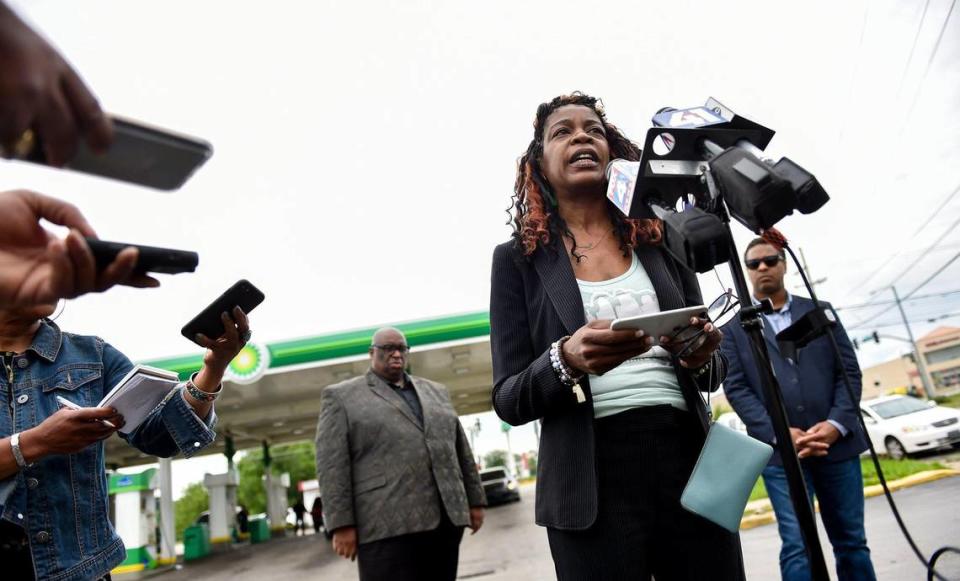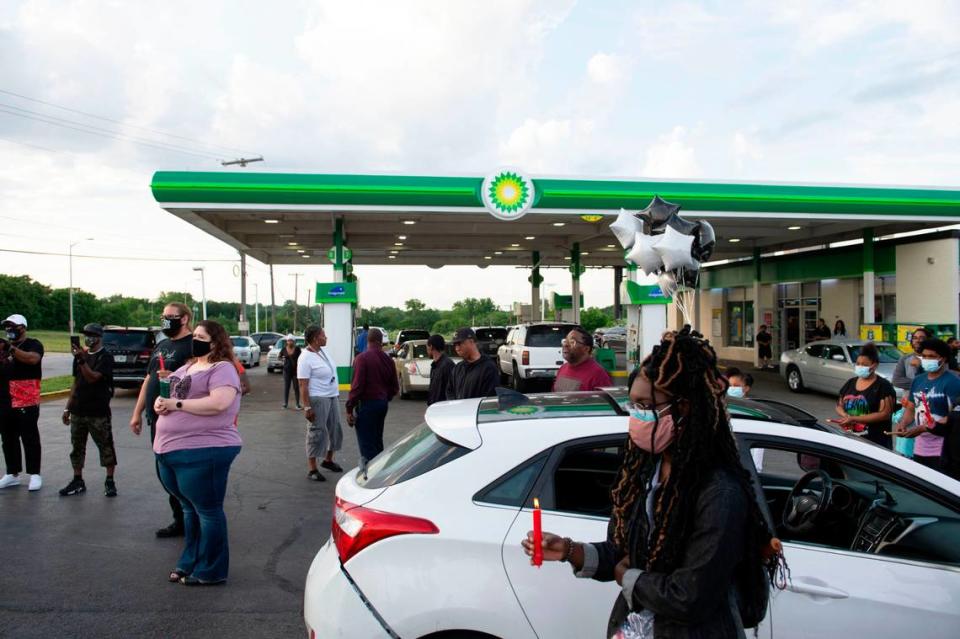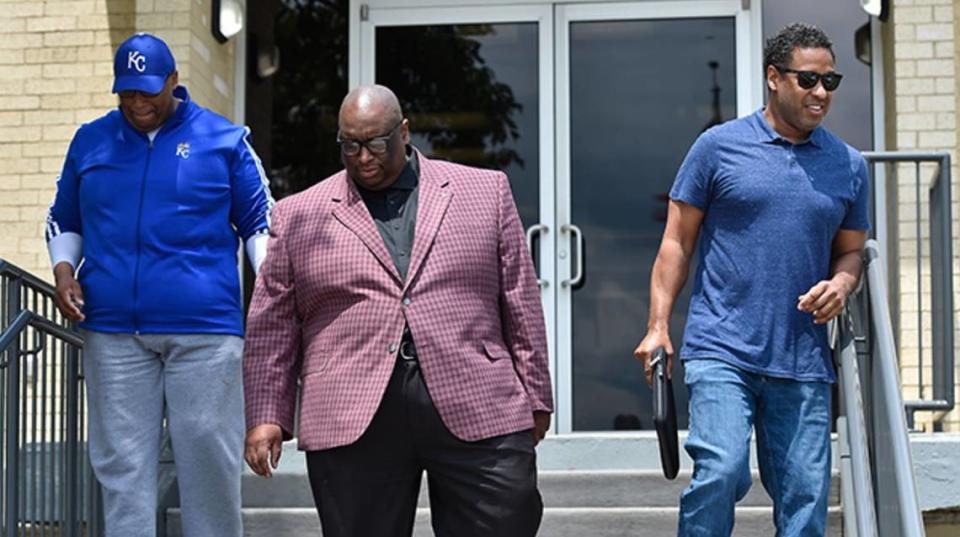‘That’s a problem’: Experts review video of fatal KCPD shooting of Malcolm Johnson
Malcolm Johnson had no chance to surrender when two Kansas City police officers confronted him in a gas station with guns drawn, according to experts who reviewed videos of the incident.
Bystanders were also put in danger by the officers’ actions, they said, and it was unclear whether Johnson was armed or willing to comply with arrest in the moments leading up to the fatal police shooting of Johnson, 31, on March 25.
The shooting, which unfolded inside a convenience store at 63rd and Prospect, has raised new questions since the videos began surfacing publicly.
On June 1, surveillance video showing officers first approaching Johnson was released by his family. That was soon followed by video shot by a store employee that shows a struggle and captures the shooting, though it was still not clear who fired the shots. It is unclear if any part of the incident was captured on police body cameras — the department wasn’t fully equipped with cameras until April 22.
Since then, experts, including a forensic scientist, former law enforcement officers and a police accountability advocate, reviewed videos of the encounter at The Star’s request.
Though questions remain about exactly what happened, they said the incident illustrated irresponsible tactics and an excessive use of force. They questioned who made the decision to arrest Johnson in such a confined space and why less lethal forms of force were not used.
“To choose to do that in a very small, contained environment where there are members of the public right next to you that are in harm’s way — that’s a problem,” said Brent Turvey, director of the Forensic Criminology Institute based in Alaska.
With the release of the videos, faith leaders, community activists and elected officials have raised questions about the shooting, saying police used deadly force on a man who was restrained. Some have said the video evidence does not match law enforcement’s initial account of what happened.
The Missouri State Highway Patrol is investigating Johnson’s death and has said the officers were trying to arrest him in connection with a previous shooting when “a fight, a struggle ensued.” The patrol said Johnson drew a handgun and shot one of the officers in the leg as two other officers arrived on the scene to assist with the arrest. The wounded officer returned gunfire, fatally wounding Johnson, the patrol said.
But a two minute, 28 second video shows a man identified as Johnson standing at the gas station counter, having just scratched off a lottery ticket when the two officers approach him with their guns drawn. They quickly grab him.
A struggle unfolds and more officers try to restrain him on the ground. The camera angle only shows the man’s feet as the confrontation continues. The video ends as an officer who appears to be wounded in the leg is rushed out of the store.
“These disturbing videos beg many questions that must be answered to ensure justice is served in this incident,” said Gwen Grant, president/CEO of the Urban League of Greater Kansas City. “It is difficult to understand how Malcolm Johnson could have shot anyone while being pinned face down on the ground with several officers on top of him.”
“What is evident is that several officers had their weapons drawn and fired shots,” Grant said. More alarming is the fact that Johnson was shot twice on the right side of the head execution style.”
The officers made the arrest when they did because they had a “stop order,” for him - a standing order to take a person into custody, said Capt. Leslie Foreman, a Kansas City Police Department spokeswoman. Foreman referred other questions about the shooting to the highway patrol.
The highway patrol has been investigating Kansas City police shootings since last summer, and recently sent its case file on the Johnson shooting to highway patrol officials in Jefferson City.
It will next be released to the Jackson County Prosecutor’s Office for a charging decision. No timetable has been set on when that would occur, Sgt. William Lowe, a spokesman for the highway patrol, said on Thursday.
Inside gas station
It would have been easier and less dangerous for the officers to wait until Johnson left the gas station before they tried to arrest him, said Terrell Carter, a former St. Louis police officer who has written extensively about law enforcement and currently is president and executive director of nonprofit Rise Community Development.
“Even when someone has committed a felony, there is not a mandate that you have to try to arrest that person in a tightly closed public space,” he said.
Turvey said the decision to confront Johnson inside the store was one of the tactical decisions that he found questionable. He wondered if the owner of the gas station, which is private property, had been informed ahead of the arrest.
As the events unfold, the scuffle between the two officers and Johnson quickly becomes a “pile-on,” Turvey said.
“There were a lot of officers there,” he said. “They were all on top of him. If they don’t have the awareness or the ability to restrain him in that fashion, in that context, then maybe that’s an indication that that’s not something they should be doing.”
Officers that are properly trained choose the appropriate context of an encounter and control the scenario, he said. In some situations, it can be as simple as approaching a suspect and talking to them.
When a person is suspected of being armed, going in with guns drawn may be necessary, but it immediately raises the stakes, Turvey said.
‘Kill shot’
When the first two officers entered the store, they pointed their guns, cornered Johnson and grabbed him.
“Mr. Johnson wasn’t given a chance to calmly surrender, he wasn’t given an opportunity to really comply,” said Lauren Bonds, the legal director for the National Police Accountability Project.
“It was just kind of, we’ve got guns, get on the ground, no opportunity to be arrested in a nonviolent manner. He wasn’t given that option or the opportunity to step outside.”
While the highway patrol has said Johnson shot one of the officers in the leg, Bonds said police could have used less lethal actions to get control of the situation. One of the videos shows an officer enter the store with a Taser just as the first shot was fired.
“Even if a firearm is used and I understand that this was an escalating situation and the police’s version was he had a gun and he fired at the officer, I think that there are less fatal ways to use a firearm than shooting someone in the temple,” Bonds said. “That’s basically kind of an execution, direct kill shot.
“So that raises the question that even if the officers’ events up until this point are 100% true, and Mr. Johnson did draw a weapon and did shoot somebody and did shoot the officer in the leg, whether there were other ways that didn’t require shooting him in the head,” she said.

It would be helpful to know what the officers knew going in, said Charles Stephenson, a former FBI agent who now operates a private security firm. That would include whether Johnson was armed.
It might be possible, for instance, that Johnson could have escaped through the store’s backdoor, Stephenson said.
“There had been something that entered into their critical thinking module that caused them to draw their weapons inside the store,” Stephenson said. “Drawing your weapon when you are approaching an armed and dangerous individual with a very bad history and who may be armed, then that’s a very valid, proactive, defensive posture.”
Aside from the witness and surveillance video, body cameras worn by the officers would provide a better understanding of what they experienced as they encountered Johnson. But it appears that the officers were not wearing body cameras at the time.
“You really can’t snap judge what goes on in these shootings,” Stephenson said.
It is unclear in the video what, if anything, the officers said to Johnson when they approached.
Outside law enforcement
The videos that have been released so far do not show how Johnson was able to access a firearm and shoot an officer, as the highway patrol said happened.
The video taken by a store employee shows at least five officers on top of Johnson when the first gunshot is heard. It is followed by two more shots.
“It is not clear whether or not Mr. Johnson had a gun,” said Damon Daniel, president of the Ad Group Against Crime. “When we talk about the use of force, and how things are being investigated, we really truly need to have a separate entity outside of law enforcement that is reviewing these use of force complaints and cases.

“I am hoping that when the case gets turned over to the prosecutor’s office that the particular committee that reviews these types of shootings reviews it with a fine tooth comb - it appears that there are some different opinions about what happened.”
Kansas City Council member Eric Bunch said he was waiting on the investigation’s conclusion to reaffirm that Johnson had fired at the officer.
“It should be easy to objectively determine if Malcolm Johnson fired a weapon prior to KCPD officers killing him,” Bunch said. “I can only hope that the truth will come out of this horrific incident.”
Calls for reform
The shooting occurred as civil rights leaders, both locally and nationally, have called for police reforms and greater accountability.
The Rev. Emanuel Cleaver III, senior pastor at St. James United Methodist Church, has been publicly releasing videos in the Johnson case along with Darron Edwards of United Believers Community Church, and Ron Lindsay of Concord Fortress of Hope Church.
Cleaver said the lack of trust in law enforcement prompted several witnesses to give video of the shooting to clergy instead of the highway patrol.
The pastors have joined other community leaders, civil rights groups and at least one neighborhood association in calling for Police Chief Rick Smith removed.

Cleaver, along with other faith leaders and Johnson’s family, are demanding that the four officers involved in Johnson’s killing be criminally charged and immediately fired. The group is prepared to go to the U.S. Department of Justice to seek a federal investigation of the shooting.
Bonds, with the National Police Accountability Project, said the Johnson case is a notable example of doubts raised about law enforcement’s narrative of a police shooting and a wider loss of trust.
“We’re seeing civilian videos and see information coming out of the community that contradicts their (law enforcement) narrative,” Bonds said.
“That’s one of the unifying themes that we see in so many of these and so many officer-involved shootings, is we hear one thing from the police and something very different comes to be true and completely undermines any confidence one would have in their accountability when these things happen.”

